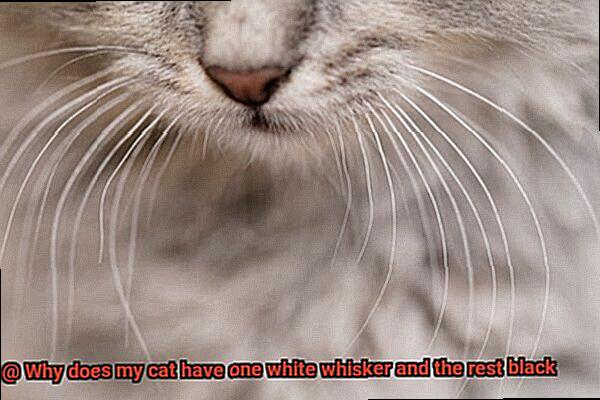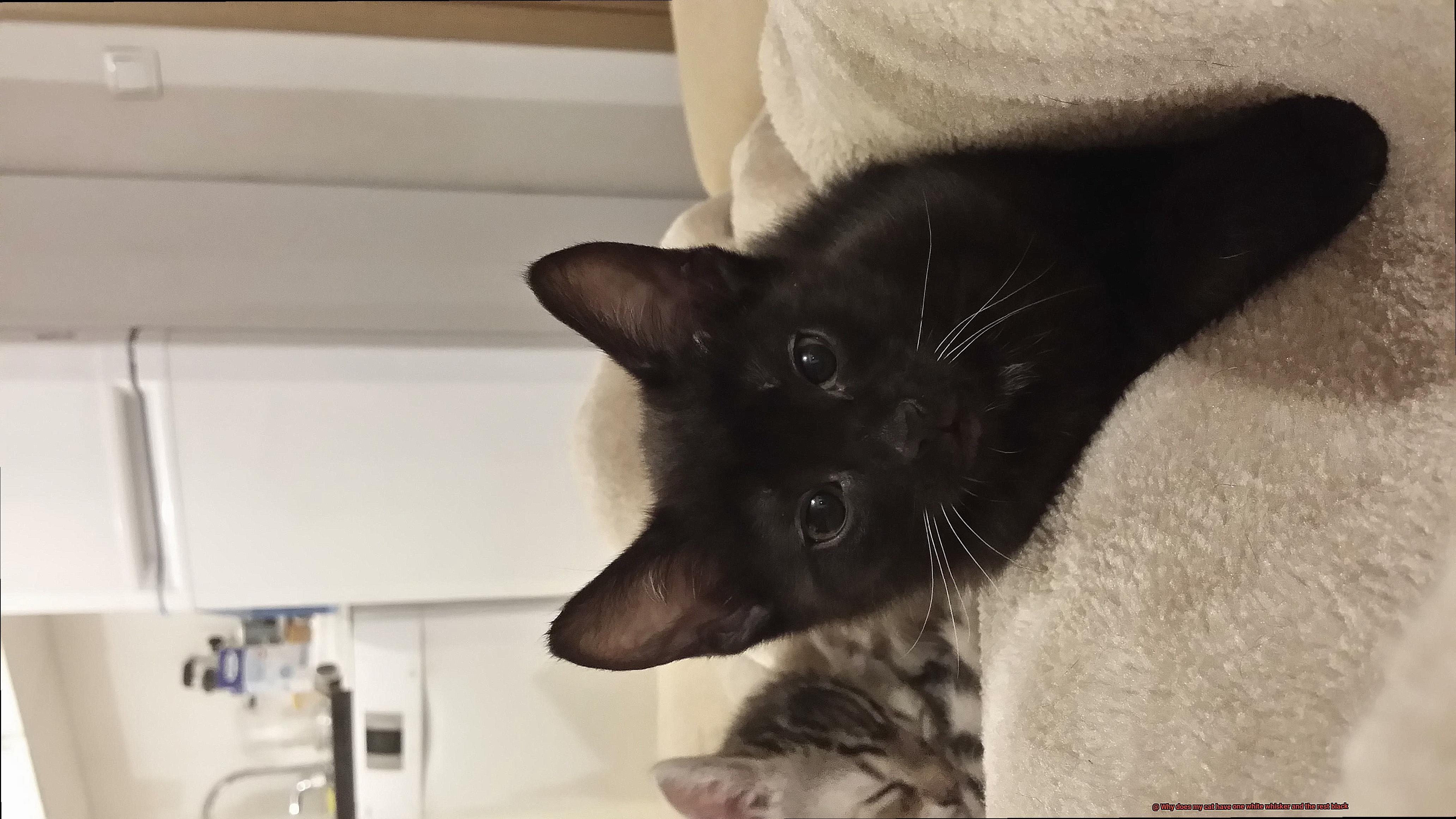Have you ever noticed that your cat has one white whisker amongst a sea of black ones? It’s a peculiar detail that may seem insignificant, but have you ever wondered why it’s there?
Believe it or not, there’s a scientific explanation behind this phenomenon. Cat whiskers, also known as vibrissae, are essential sensory tools for felines. These long, stiff hairs help them navigate their environments and detect prey by sending signals to the brain through connected nerves.
The reason for that single white whisker is due to a genetic mutation. This mutation causes the pigment-producing cells, called melanocytes, to stop producing color in that particular whisker. While cats having variations in fur color isn’t uncommon, having a different colored whisker is definitely unique.
It’s important to note that sudden changes in your cat’s whisker color can indicate underlying health issues. So if you notice any unusual changes or your cat appears to be in discomfort, it’s best to consult with your veterinarian.
In conclusion, that one white whisker may seem like a small detail, but it adds another fascinating aspect to our feline friends’ uniqueness and specialness.
The Color of a Cat’s Whiskers: What Determines It?
Cats are known for their unique and mysterious traits that often leave us wondering about their origins. One such trait is the color of their whiskers. Have you ever seen a cat with one white whisker among black ones and wondered why? Well, it turns out that the color of a cat’s whiskers is determined by genetics, just like the color of their fur, eyes, and nose.
Whiskers are not just ordinary hairs; they are specialized hairs that are thicker and longer than regular hairs. They have a rich blood supply and are deeply rooted in a cat’s skin, making them highly sensitive. Whiskers play an essential role in a cat’s life as they help them navigate their surroundings and sense changes in their environment.
So, what determines the color of a cat’s whiskers? The answer lies in the melanin pigment produced by the hair follicles. Melanin gives hair its color, and the amount produced determines whether the hair will be black, brown, or white. Therefore, when a cat has one white whisker and the rest black, it means that the hair follicle producing that whisker did not produce enough melanin.

The lack of melanin production can happen due to various reasons. It could be due to genetics, where a cat inherited a gene that causes uneven pigmentation. Aging can also affect melanin production; as kittens grow older, their whiskers darken to match the color of their fur. Another possible reason could be injury or trauma to the hair follicle, which can disrupt melanin production.
It’s worth noting that a cat’s diet can also affect the color of their whiskers. If a cat is deficient in certain nutrients, it can cause their whiskers to become discolored or even fall out. Therefore, it’s crucial to provide cats with a balanced diet to ensure they get all necessary nutrients.

Reasons for Uneven Pigmentation in Cats
Cats are fascinating creatures that come in all shapes and sizes, with unique quirks and traits that make them stand out. One of these traits is uneven pigmentation, also known as piebaldism, which can cause patches of white or light-colored fur mixed with their normal coloring. But what causes this unusual occurrence? Let’s explore the various reasons for uneven pigmentation in cats.
Genetics
One of the most common causes of uneven pigmentation in cats is genetics. Some breeds, such as Turkish Vans and Japanese Bobtails, are more prone to asymmetrical pigmentation due to their genetic makeup. These cats may have one white paw or even a white tail tip, making them even more adorable.
Age-related Changes
As cats age, their fur color and texture may change due to changes in the production of melanin. This can lead to uneven pigmentation, such as a cat having one white whisker among black ones. Exposure to sunlight can also cause fur to fade or change color, leading to asymmetrical pigmentation.
Injury or Trauma
Injury or trauma to a cat’s hair follicles can also cause uneven pigmentation. When a hair follicle is damaged, it may produce a different color of hair than normal, resulting in patches of white or light-colored fur among the cat’s normal coloring.
Medical Conditions
In some rare cases, uneven pigmentation may be a sign of an underlying medical condition. Skin disorders like vitiligo can cause loss of pigmentation in patches throughout the body, including whiskers. Hormonal imbalances and nutritional deficiencies can also affect melanin production and lead to uneven pigmentation.
Natural Variation
Overall, uneven pigmentation in cats is usually not something to worry about as it is often simply a natural variation caused by genetics or age-related changes. It is not a cause for alarm but rather another fascinating trait of these amazing creatures. However, if you notice any changes in your cat’s fur or skin, it’s always best to consult with your veterinarian to rule out any underlying health issues.
Genetics and Inherited Traits
Well, the answer lies in the fascinating world of genetics and inherited traits.
To begin with, let’s explore the basics of genetics. Genes are responsible for determining many physical characteristics, including a cat’s coat color and pattern. These genes are located on chromosomes inherited from both parents, with each gene having two forms or alleles.
The combination of alleles determines the color of a cat’s coat and whiskers. For instance, if a cat inherits two dominant alleles for black fur color, they will have black fur. Alternatively, if they receive two recessive alleles for white fur color, they will have white fur. It’s all about the specific combination of genes.

However, whisker color isn’t always determined by the same genes that dictate coat color. Whisker color can be influenced by other genetic factors such as the KIT gene. This gene controls the migration of pigment-producing cells during embryonic development, which can lead to unique coloring patterns in different parts of the body, including the whiskers.
Therefore, if your cat has one white whisker while the rest are black, it could be due to a genetic mutation or merely a unique expression of their genetic makeup. Besides, certain breeds might have specific whisker patterns or colors due to selective breeding practices.
Aging and Hair Follicle Changes
As your furry friend ages, their hair follicles undergo a natural transformation that may cause a white whisker to appear among a sea of dark ones. This is a common occurrence and nothing to be concerned about.
The color of hair is determined by the quantity and type of pigment produced by melanocytes, which are cells located in the hair follicle. As cats age, the number of melanocytes decreases, leading to a reduction in pigment production. This can result in a change in hair color, including the appearance of white or gray hairs.
Additionally, as cats age, their hair becomes thinner and more brittle, which can cause whiskers to break or fall out. But don’t fret. When a whisker falls out, it will eventually be replaced by a new one. However, the new whisker may have less pigment than the old one, resulting in a white or gray appearance.
It’s important to note that even though changes in hair color and texture are typical as cats age, they can also indicate underlying health concerns. So if you observe significant changes in your cat’s hair or skin, it’s always best to consult with your veterinarian to rule out any potential health issues.
Injury or Trauma to the Hair Follicle
This could be a harmless quirk, but it could also be a result of injury or trauma to the hair follicle.
Whiskers are not just cute accessories on your cat’s face; they’re highly sensitive and play a crucial role in helping them navigate and sense their surroundings. But did you know that whiskers are thicker and sturdier than regular hairs, yet still originate from hair follicles?
If a hair follicle is damaged or injured, it can affect the pigment-producing cells called melanocytes and cause the production of a white whisker instead of a black one. This trauma or injury could be caused by an infection or inflammation in the skin around the whisker, or physical trauma such as a fight or accident.
While injury or trauma to the hair follicle is one possible explanation for your cat’s white whisker, other factors such as genetics or age could also play a role. It’s always best to consult with your veterinarian if you notice any changes in your cat’s whiskers or skin around them to rule out any underlying medical conditions.
QgShm9bBF6s” >
Conclusion
To wrap things up, a cat’s whisker color is determined by genetics, just like their fur, eyes, and nose. Whiskers are not your typical hairs; they’re specialized hairs that help cats navigate their surroundings and sense changes in their environment. The absence of melanin production can be due to various factors such as genetics, aging, injury or trauma to the hair follicle, or even a deficient diet. However, sudden changes in your cat’s whisker color may indicate underlying health issues. In such cases, it’s always best to consult with your veterinarian if you notice significant changes in your cat’s hair or skin.
Uneven pigmentation in cats is usually nothing to fret about as it’s often simply a natural variation caused by genetics or age-related changes. Other genetic factors such as the KIT gene can also influence this phenomenon. Aging can cause a white whisker to pop up among dark ones due to reduced pigment production. Similarly, an injury or trauma to the hair follicle can trigger the production of a white whisker instead of a black one.
In essence, that one white whisker might seem like a minor detail but it adds another layer of intrigue to our feline companions’ uniqueness and individuality.







